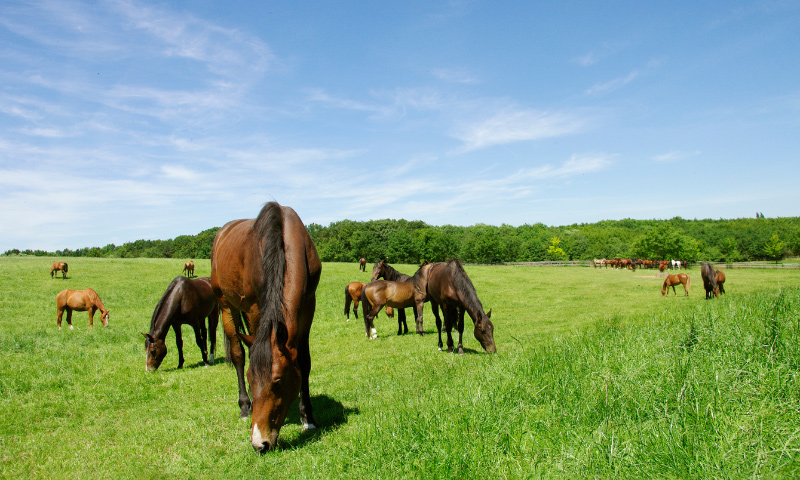As we prepare horses for the upcoming year of competing, no matter what your chosen discipline is there are a few important things that you can do to help reduce your horse’s risk of developing gastric ulcers.
Equine gastric ulcer syndrome (EGUS) is a common issue that concerns horses worldwide and estimates have indicated the prevalence of horses affected to be from 53 to 93% depending on the population surveys and type of athletic activity (Andrews, 2005).
Gastric ulcers are open wounds in the stomach and most commonly occur in the non-glandular mucosa of the stomach. EGUS is caused by many factors including diet, restricted feed intake, the stomach anatomy, stress, exercise and the use of non-steroidal anti-inflammatory medications.
It is well documented that horses grazing at pasture have a decreased prevalence of gastric ulcers compared to horses that have intermittent access to forage. This is because during grazing there is a continuous flow of saliva and ingesta that buffers the stomach acid for a large portion of the day. When horses are withheld from feed the gastric pH drops rapidly and the non-glandular portion of the stomach is exposed to an acid environment.
One simple step that you can take each and every day to minimise your horse’s risk of developing gastric ulcers is to ensure that your horse has had access to sufficient amounts of grass and hay before you ride them.
The horse’s stomach is NEVER supposed to be empty as it relies on there being a physical barrier (food that is high in fibre such as grass/hay) to protect itself from the acid from the protected lower (glandular area) from splashing up to the unprotected top part (squamous or non-glandular area) and damaging it.
It is recommended to feed hay 30 to 60 minutes prior to riding to give your horse’s stomach a chance to fill up. Lucerne hay is ideal to use as it may have some protective effect on the non-glandular mucosa in horses. Research has found that horses fed Alfalfa (Lucerne) hay had reduced instances and severity of non-glandular squamous gastric lesions leading researchers to conclude that Alfalfa may buffer stomach acid in horses (Nadeau, et al, 2000).
Other risk factors for gastric ulcers to be aware of are:
- Exercise intensity – horses in training and racing are at high risk of developing EGUS especially if they are exercised on an empty stomach.
- Intermittent feeding (extended periods of time without feed) – where horses are usually stabled and fed intermittently it has shown to cause and to increase the severity of gastric ulcers (Murray, 1994).
- Diet – horses that are fed high-concentrate diets are more prone to developing gastric ulcers than horses that have a high forage diet.
- Stabling – stall confinement has been found to be associated with a greater risk of gastric ulcers.
- Stress – Research undertaken by Malmkvist et al (2012) discovered that horses with severe glandular ulcers had a higher stress hormone response to novelty, thus they were more stress sensitive. Consequently, handling horses in ways that evoke stress in horses should be limited to reduce the development of gastric ulcers or to protect horses with this condition.
- Transport – during transport feed and water consumption is generally reduced which may cause an increase in the incidence of EGUS.
- Nonsteroidal Anti-inflammatory drugs (NSAIDs)– such as phenylbutazone or “bute” can cause gastric ulcers. In a recent study (Pedersen, et al 2018) found that all horses treated with phenylbutazone developed grade 2 or greater (out of 4) glandular ulceration, whereas untreated horses did not.
Along with never exercising horses on an empty stomach, here are a few more management strategies that you can implement to help reduce the incidence and severity of gastric ulcers:
- Provide horses with a forage-based diet. Chewing grass and hay produces lots of saliva which in turn helps buffer the stomach. As previously stated, incorporating a proportion of Lucerne hay into the diet can be beneficial.
- Take steps to reduce stress such as providing plenty of paddock turnout time and preferably with a buddy.
- If your horse doesn’t have unlimited access to pasture, provide regular small meals with constant access to hay. Supplying hay in slow feeder hay nets helps to extend the time taken for the horse to consume all of the hay. This in turn extends salivation time and helps reduce boredom.
- Along with feeding hay to horses prior to exercise, it is also important that a small meal of hay is provided at the completion of exercise to help buffer the stomach and keep it full.
- Don’t forget to provide hay prior to transport and if you are travelling long distances consider supplying hay in a slow feeder hay net (make sure it isn’t dusty). It is also recommended to plan breaks to give horses opportunities to graze and drink. Richards (2018) suggests the strategic use of gastric ulcer medication (omeprazole or ranitidine) just prior to and during travel to cut the acid production if you are planning to travel long distances.
- Finally, making sure your horse has a balanced diet will go a long way towards assuring overall health and performance.
If you are concerned that your horse may be suffering from gastric ulcers, contact your veterinarian for treatment advice.
Written by AgSolutions Technical Advisor
Shannon Godwin BAppSc GDTL
